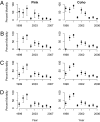Effects of parasites from salmon farms on productivity of wild salmon
- PMID: 21873246
- PMCID: PMC3167527
- DOI: 10.1073/pnas.1101845108
Effects of parasites from salmon farms on productivity of wild salmon
Abstract
The ecological risks of salmon aquaculture have motivated changes to management and policy designed to protect wild salmon populations and habitats in several countries. In Canada, much attention has focused on outbreaks of parasitic copepods, sea lice (Lepeophtheirus salmonis), on farmed and wild salmon in the Broughton Archipelago, British Columbia. Several recent studies have reached contradictory conclusions on whether the spread of lice from salmon farms affects the productivity of sympatric wild salmon populations. We analyzed recently available sea lice data on farms and spawner-recruit data for pink (Oncorhynchus gorbuscha) and coho (Oncorhynchus kisutch) salmon populations in the Broughton Archipelago and nearby regions where farms are not present. Our results show that sea lice abundance on farms is negatively associated with productivity of both pink and coho salmon in the Broughton Archipelago. These results reconcile the contradictory findings of previous studies and suggest that management and policy measures designed to protect wild salmon from sea lice should yield conservation and fishery benefits.
Conflict of interest statement
The authors declare no conflict of interest.
Figures


Similar articles
-
Physiological consequences of the salmon louse (Lepeophtheirus salmonis) on juvenile pink salmon (Oncorhynchus gorbuscha): implications for wild salmon ecology and management, and for salmon aquaculture.Philos Trans R Soc Lond B Biol Sci. 2012 Jun 19;367(1596):1770-9. doi: 10.1098/rstb.2011.0423. Philos Trans R Soc Lond B Biol Sci. 2012. PMID: 22566682 Free PMC article. Review.
-
Sea-louse parasites on juvenile wild salmon in the Broughton Archipelago, British Columbia, Canada.Ecology. 2016 Jul;97(7):1887. doi: 10.1002/ecy.1438. Ecology. 2016. PMID: 27859168
-
Sea lice, Lepeophtheirus salmonis, transfer between wild sympatric adult and juvenile salmon on the north coast of British Columbia, Canada.J Fish Dis. 2009 Jan;32(1):45-57. doi: 10.1111/j.1365-2761.2008.01003.x. J Fish Dis. 2009. PMID: 19245630
-
Relationship of farm salmon, sea lice, and wild salmon populations.Proc Natl Acad Sci U S A. 2010 Dec 28;107(52):22599-604. doi: 10.1073/pnas.1009573108. Epub 2010 Dec 13. Proc Natl Acad Sci U S A. 2010. PMID: 21149706 Free PMC article.
-
How sea lice from salmon farms may cause wild salmonid declines in Europe and North America and be a threat to fishes elsewhere.Proc Biol Sci. 2009 Oct 7;276(1672):3385-94. doi: 10.1098/rspb.2009.0771. Epub 2009 Jul 8. Proc Biol Sci. 2009. PMID: 19586950 Free PMC article. Review.
Cited by
-
Impact of parasites on salmon recruitment in the Northeast Atlantic Ocean.Proc Biol Sci. 2013 Jan 7;280(1750):20122359. doi: 10.1098/rspb.2012.2359. Epub 2012 Nov 7. Proc Biol Sci. 2013. PMID: 23135680 Free PMC article.
-
Physiological consequences of the salmon louse (Lepeophtheirus salmonis) on juvenile pink salmon (Oncorhynchus gorbuscha): implications for wild salmon ecology and management, and for salmon aquaculture.Philos Trans R Soc Lond B Biol Sci. 2012 Jun 19;367(1596):1770-9. doi: 10.1098/rstb.2011.0423. Philos Trans R Soc Lond B Biol Sci. 2012. PMID: 22566682 Free PMC article. Review.
-
Migratory hosts can maintain the high-dose/refuge effect in a structured host-parasite system: The case of sea lice and salmon.Evol Appl. 2020 Sep 10;13(10):2521-2535. doi: 10.1111/eva.12984. eCollection 2020 Dec. Evol Appl. 2020. PMID: 33294006 Free PMC article.
-
Lessons from sea louse and salmon epidemiology.Philos Trans R Soc Lond B Biol Sci. 2016 Mar 5;371(1689):20150203. doi: 10.1098/rstb.2015.0203. Philos Trans R Soc Lond B Biol Sci. 2016. PMID: 26880836 Free PMC article. Review.
-
Modelling the impact of temperature-induced life history plasticity and mate limitation on the epidemic potential of a marine ectoparasite.PLoS One. 2014 Feb 5;9(2):e88465. doi: 10.1371/journal.pone.0088465. eCollection 2014. PLoS One. 2014. PMID: 24505493 Free PMC article.
References
-
- Krkošek M, et al. Declining wild salmon populations in relation to parasites from farm salmon. Science. 2007;318:1772–1775. - PubMed
-
- Costello MJ. Ecology of sea lice parasitic on farmed and wild fish. Trends Parasitol. 2006;22:475–483. - PubMed
-
- Morton AB, Williams R. First report of a sea louse, Lepeophtheirus salmonis, infestation on juvenile pink salmon, Oncorhynchus gorbuscha, in nearshore habitat. Can Field Nat. 2003;117:634–641.
Publication types
MeSH terms
LinkOut - more resources
Full Text Sources

